Everyone loves flowers, but not everyone dares to breed them at home, fearing the difficulties in caring for them. However, there are plenty of hardy houseplants that are perfect for your apartment or office.
Below you will find out which indoor flowers are the most unpretentious, and you can also see their photos and read the recommendations for caring for these plants.
What indoor flowers are the most unpretentious: aloe (Aloe)
Family: Asphodelaceae, deciduous-decorative, photophilous.
Aloe or agave is a small tree or shrub with an erect stem and juicy fleshy leaves of a dull green or bluish color.
In aloe tree (Aloe arborescens) they are narrow-lanceolate with strong spines bent upward along the edge.

And in Aloe folded (Aloe plicatilis) – belt-like with a rounded top.
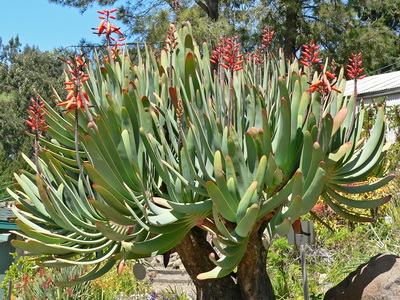
Broadly lanceolate leaves with white hooked thorns and a colorless awn at the end of spinous aloe (Aloe aristata) are collected in dense basal rosettes.
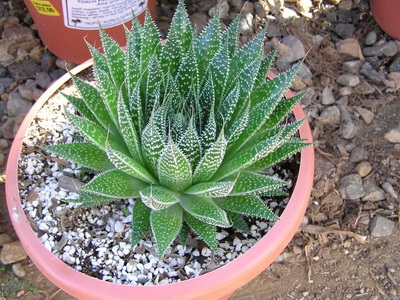
Spectacular triangular-lanceolate leaves with transverse whitish stripes of variegated aloe, or tiger (Aloe variegate), also form rosettes.
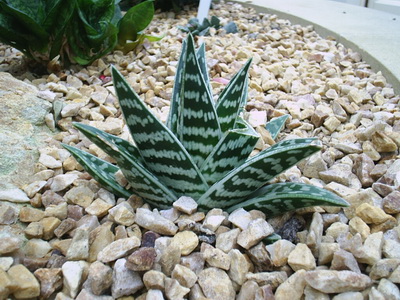
And the most medicinal unpretentious of indoor flowers is considered to be real aloe, or Barbados (Aloe vera, barbadensis), with narrow, serrated, almost erect bluish-green leaves.

Aloe absorbs harmful chemical compounds from the air (nitric oxide, formaldehyde) emitted by thermal insulation and furniture made of chipboard, and has a very high phytoncidal activity against many pathogens.
Aloe juice is widely used in traditional medicine recipes, and the pulp of the leaves is used in various cosmetic masks.
These unpretentious indoor flowers are placed in a well-lit place, not afraid of direct sunlight. Water abundantly in summer, and very rarely in winter.
Spraying is desirable, but not required. Feed only in the summer 1-2 times a month. You can transplant every 2-3 years, using a soil mixture of soddy soil, leafy soil and sand (2: 1: 1) or ready-made for cacti and succulents.
Unpretentious beautiful indoor plant Aspidistra
Family: Lily, deciduous-decorative, shade-tolerant.
Aspidistra (Aspidistra) , “friendly family”, or “shoemaker’s palm”, is a perennial herbaceous plant with large oval or broadly lanceolate glossy leaves on long strong petioles.
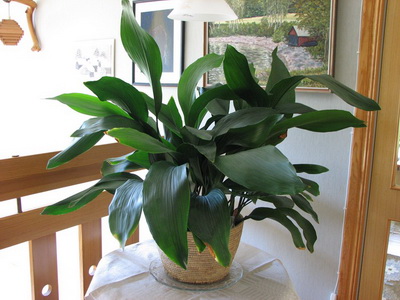
Along with plain dark green leaf blades, there is a decorative form ‘Variegata’ with leaves in longitudinal white, cream or yellow stripes. Growing, it occupies the entire area provided.

As the popular name (“shoemaker’s palm”) testifies, this unpretentious beautiful houseplant can grow in rather difficult conditions: moderate shading (variegated forms require a lighter place, otherwise the brightness of colors is lost), low humidity, high dust content, slight interruptions in watering . It is afraid of drafts, moisture stagnation and transplants (transplanted in the spring when the container becomes very tight). The soil mixture is made up of sod land, compost, peat and sand (1: 1: 1: 1).
Of the useful qualities, one can name a sound-absorbing effect, an increase in air humidity and volatile activity against a number of pathogenic microorganisms.
Unpretentious indoor plant for the office Zamioculcas
Family: Aroid, deciduous-decorative, photophilous.

Zamioculcas (Zamioculcas) is a tuberous plant with thick stems 50-100 cm high, on which dark green glossy fleshy leaves pointed at the ends with yellow-green veins sit in pairs.
This unpretentious houseplant for the office is ideal for decorating the workspace due to its highly decorative properties and unpretentious care. Zamioculcas is resistant to drought (excess moisture can cause root rot), dry air (leaves can be occasionally washed in the shower), low light (but it will not suffer on a lit window), and is rarely attacked by various pests.
Top dressing is carried out only when a new leaf appears and until it is fully developed, it is better to use fertilizers for cacti and succulents . Adult plants are transplanted every 3-5 years into a soil mixture of soddy and leafy soil, peat and sand (1: 1: 1: 1).
In addition, the name “dollar tree” was assigned to the zamiokulkas, and popular rumor ascribes to it the ability to attract wealth.
Unpretentious indoor flowering plant Zygocactus
Family: Cactus, flowering, photophilous.
Unpretentious blooming indoor flower Zygocactus (Schlumbergera, or “Decembrist” – Zygocactus, Schlumbergera) truncated (truncates) – the same “Decembrist”, which, one of the few, pleased our grandmothers on cold winter evenings with juicy bright crimson tropical elegant flowers.
Since then, a huge number of new varieties have been bred, differing both in the shape of segmented shoots (sharper or rounder, larger or smaller), and in the amazing richness of colors of large (up to 8 cm long), fragrant, arranged one by one or a group of flowers.
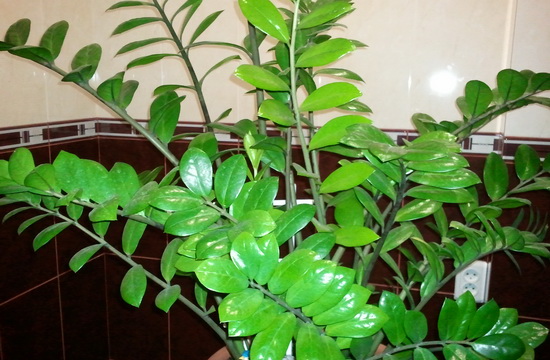
As you can see in the photo of this unpretentious flowering plant, in addition to the traditional red and white flowers, there are varieties with salmon, lavender, red-orange, peach, orange-red, yellow and multicolor colors.
Currently, the range of colors and shapes is constantly updated.
Transplanted after flowering, when the container becomes cramped (blooms irregularly and less abundantly in a spacious container). The soil should contain a mixture of humus, leafy, soddy soil and sand (3:1:1:2), you can use a ready-made mixture for cacti and succulents.
The unpretentious indoor flowering plant zygocactus requires only one condition to be met – do not move the plant at the time of budding, otherwise all flower buds may fall off. In all other respects, this representative of forest cacti will not cause much trouble: diffused, rather bright lighting, regular watering in spring and summer, as well as during the budding period (from September to December).
Unpretentious indoor plant nephrolepis
Family: Nephrolepisaceae, deciduous-decorative, shade-tolerant.
Nephrolepis (Nephrolepis) is another representative of the oldest class of ferns. Unlike many other species, it has perfectly adapted to the climatic conditions of our apartments and is successfully used to “revitalize” corners that are quite remote from windows.

Its light green, pinnate, arcuately drooping fronds add lightness and airiness to any composition.

Large specimens (fronds can reach 1.5 m) are excellent in splendid isolation on a high stand.
It prefers a moderate temperature regime of about +15 … +20 ° С, it will be grateful for regular watering and spraying, but it will survive a short-term drought without much loss.
It reacts poorly only to combustion products and tobacco smoke, so it is unlikely to grow well in the kitchen or in the “smoking room” (for this room it is generally difficult to pick up something other than an artificial palm tree).
Top dressing is carried out in spring and summer once every 2 weeks. For planting, use a mixture of leafy soil and compost (1: 1) with the addition of bone meal.
What flowering houseplants are unpretentious: spathiphyllum
Family: Aroid, flowering, deciduous-decorative, photophilous.
If you do not know what other indoor plants are unpretentious and do not require constant care, we advise you to start a spathiphyllum ( Spathiphyllum ).
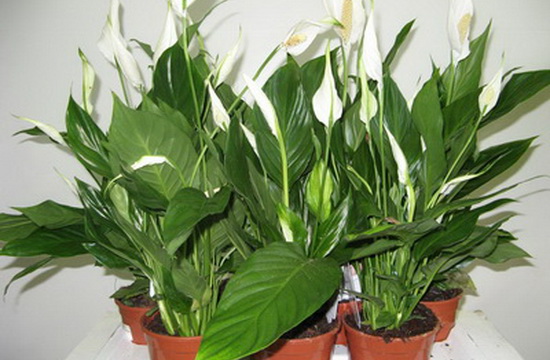
This flower can be seen in places that seem to be the most unsuitable for living flowers – poorly lit, often only with artificial lighting, halls or reception rooms filled with various vapors and aerosols of hairdressers or dry cleaners, hallways and stairs.
Not only does it look magnificent due to the abundance of large xiphoid dark green leaves on long petioles, like Wallace’s spathiphyllum (Spathiphyllum wallisii) .
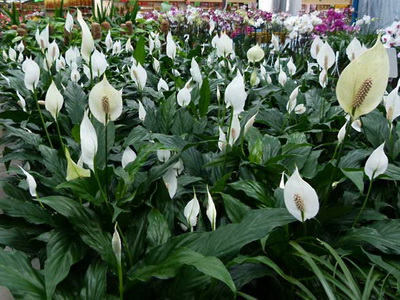
Or light green with a wavy edge, like a profusely flowering spathiphyllum (Spathiphyllum floribundum) , but also blooms.

And the inflorescence of some varieties is only slightly inferior in beauty to the graceful anthurium – a small yellow “cob”, half-covered with a waxy white or greenish leaf-blanket on an upright peduncle. This is one of the most unpretentious flowering houseplants, blooming from late spring and all summer. For active growth and abundant flowering, it is still better to place in a bright, warm place with high humidity, water and spray regularly. For active growth and abundant flowering, it is still better to place in a bright, warm place with high humidity, water and spray regularly. For active growth and abundant flowering, it is still better to place in a bright, warm place with high humidity, water and spray regularly. From spring to autumn, top dressing is carried out once a month.

From spring to autumn, top dressing is carried out once a month.
This is one of the most unpretentious blooming indoor flowers, it perfectly moisturizes the air, reduces the content of some harmful substances in it emitted by modern polymeric materials, saturates the air with ozone and air ions.
Unpretentious houseplant scindapsus
Family: Aroid, deciduous-decorative, shade-tolerant.
Scindapsus (Scindapsus) – a fast-growing vine with a tetrahedral stem and juicy heart-shaped or ovate leaves with a shiny surface.

Pay attention to the photo of this unpretentious houseplant:
There are varieties with plain dark green leaves;
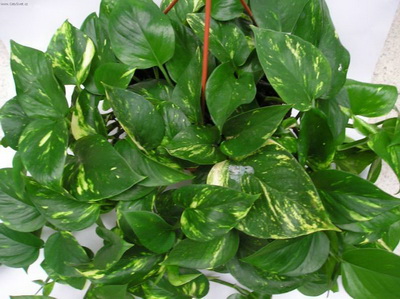
Or with silver spots;
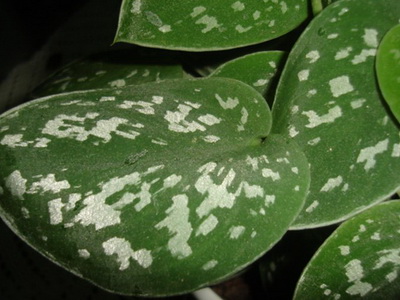
Or with a border around the edges;
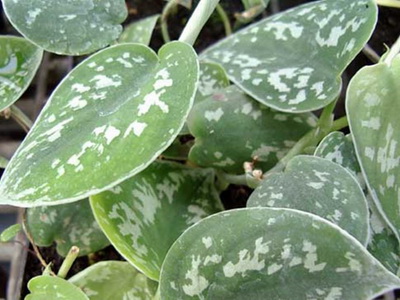
Or with golden “strokes”, thanks to which even in the depths of the room the impression of the presence of “sunbeams” is created.

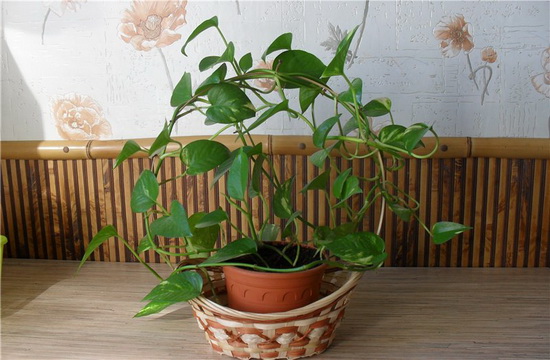
Without any effort on your part, the scindapsus will braid the proposed support. Its aerial roots manage to “stick” even to the unevenness of the wallpaper or plaster.
A pole with coconut fiber or moss, densely entwined with scindapsus, looks very nice.
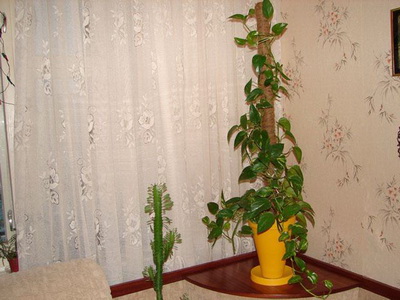
It is only necessary to plant several plants in one container and periodically pinch the ends of the shoots to stimulate the growth of lateral stems – this way the planting will be more dense and beautiful.
The plant is shade-tolerant, but with a prolonged lack of lighting, the brightness of colors is lost. For a long time it can grow only under artificial lighting. Sufficient watering and heat (+20…+25 °С) are necessary for good growth. Top dressing is carried out from spring to autumn once every two weeks. Replant in the spring as needed.
Scindapsus not only takes dust from the air in large quantities, but also enriches it with phytoncides and ozonides (substances that contribute to the death of pathogenic microorganisms).
Unpretentious plant fat woman
Family: Crassula, deciduous-decorative, photophilous.
Crassula (Crassula) or “money tree” is loved by flower growers not only for its unpretentiousness, but also for its original appearance.
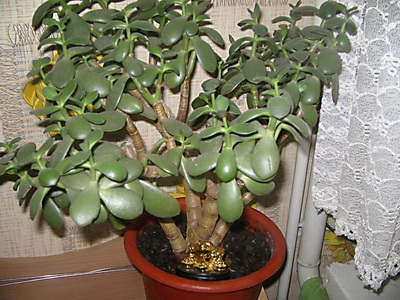
Crassula portulaceae, or silver (Crassula portulaceae argentea) , the most common species, looks like a stocky tree (can grow up to 1 m tall) with round dark green “coin” leaves. The flowers are small white or pink.
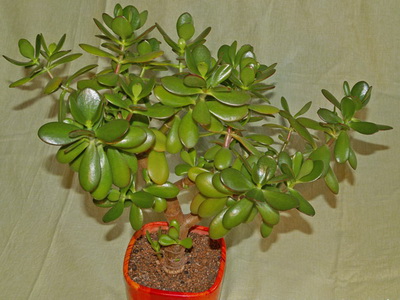
The larger tree-like fat woman (Crassula arborescens) is also similar to it, but it has oval-shaped, bluish leaves.
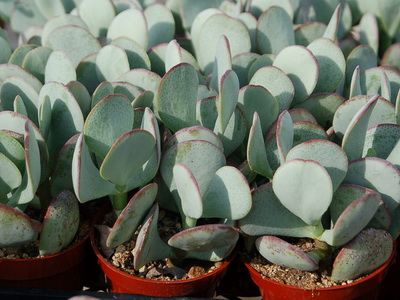
The four-sided fat woman (Crassula tetragona) is more like a club moss – its thin decumbent shoots are densely covered with numerous short-subulate, fleshy leaves.

The fat woman is photophilous and drought-resistant. In winter, the temperature is +8…+12 °C. Top dressing is carried out only in the warm season once a month. Transplanted every 2-3 years, in wide low containers, using a soil mixture of soddy and leafy soil, sand, peat (1: 1: 1: 0.5).
It is believed that the fat woman attracts good luck and financial prosperity to the house. Why not try it, because the cost of it is definitely minimal.
Unpretentious indoor plant tradescantia
Family: Commeline, ornamental, photophilous, shade-tolerant.
Tradescantia (Tradescantia) is a herbaceous perennial plant with succulent creeping stems and tight-fitting oval-pointed leaves.
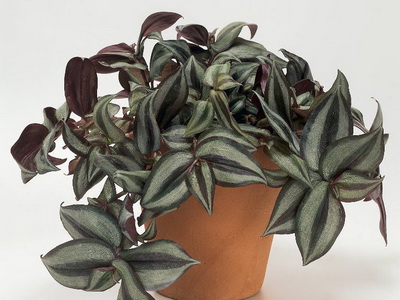
River Tradescantia (Tradescantia fluminensis) has purple shoots, the upper side of the leaf is bright green with yellow stripes, and the lower side is purple.

White-flowered tradescantia (Tradescantia albiflora) is simply bright green, but there are forms with striped foliage: white and dark green stripes on a light green background, or green stripes on yellow leaves, or white and pink on a green background. The flowers are small white, collected in inflorescences, curls.
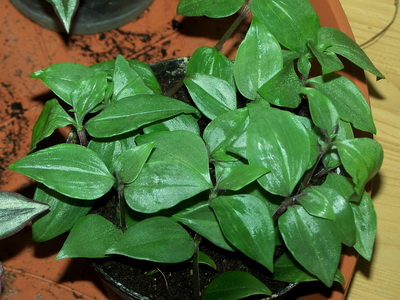
Tradescantia grow equally well in both light and dark rooms, they easily tolerate dry air. “Striped” varieties need a little more light, as in low light the color of the stripes will be less saturated. In terms of care, only regular watering is required (it can be sprayed periodically) and annual rejuvenation with pruning, as the shoots are strongly drawn out during the year and can become bare at the base. For planting, take a soil mixture of leafy soil, humus, peat and sand (2: 1: 1: 1).
Tradescantia promotes sound absorption and humidification of the air, emits a small amount of phytoncides.
Beautiful unpretentious plant cyperus
Family: Sedge, deciduous-decorative, photophilous.
Cyperus (Cyperus ) alternate-leaved, or sitovnik (Cyperus alternifolius), is an upright herbaceous plant with linear green leaves (up to 1 m long and up to 0.5 cm wide), collected in umbellate panicles.
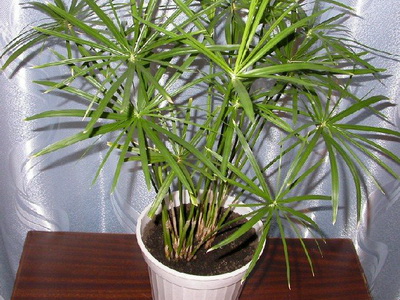
The form ‘Variegatus’ has leaves with white stripes.
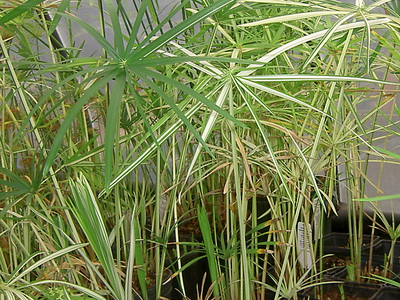
And the graceful cyperus (Cyperus gracilis) is a dwarf species (up to 50 cm tall).
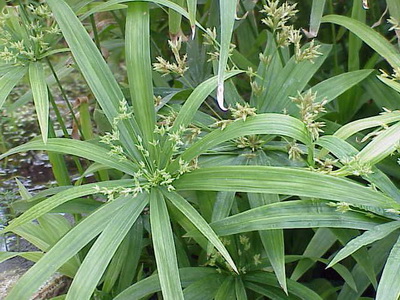
Cyperus papyrus (Cyperus papyrus) – the highest (can grow up to 3 m) with thread-like leaves.
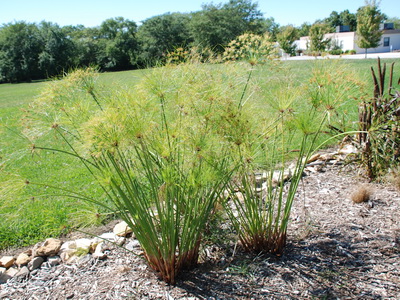
And Cyperus diffuses has the widest leaves.

This beautiful unpretentious indoor plant is grown in pots or tubs. The place is chosen bright, humid and warm (+20 … +22 ° C in summer, a little cooler in winter). The problem with high humidity and constantly damp soil can be easily solved by placing the plant pot in another, wider container half-filled with water. Feed only in the summer once every two weeks. Fertilizer should be taken in half concentration. They are transplanted every 3-4 years at any time when braiding a clod of earth with roots. For planting, use an earthen mixture of soddy and leafy soil, peat, compost and sand (1:1:2:1). In summer, it will successfully decorate a pond in your garden (exposed in shallow water right in pots).
In summer, it will successfully decorate a pond in your garden (exposed in shallow water right in pots). Cyperus is recommended for rooms where there are many computers or other office equipment, since the moisture evaporated by the plant reduces the content of charged dust particles in the air.
And if there is a cat in the house, then for her it will be an invaluable gift.
Indoor unpretentious plant cissus
Family: Grape, deciduous-decorative, shade-tolerant.
Cissus (Cissus) – another old-timer of various offices and institutions – rhomboid cissus, or “birch” (Cissus rhombifolia).
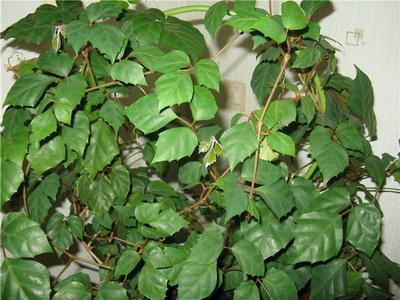
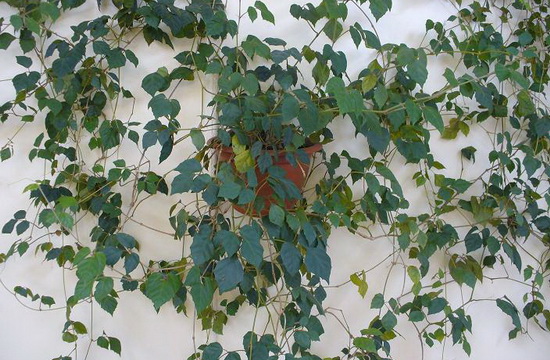
Climbing liana with thin, abundantly branching shoots and trifoliate dark green leaves. Clings to everything around with long thin antennae. Stems and petioles are covered with brown short hairs.
More rare types:
Cissus antarctica, or “indoor grapes” (Cissus antarctica), with ovate large (up to 12 cm) dark green leaves;

And cissus multi-colored (Cissus discolor) – with reddish-purple stems and a silvery pattern on heart-shaped reddish leaves.
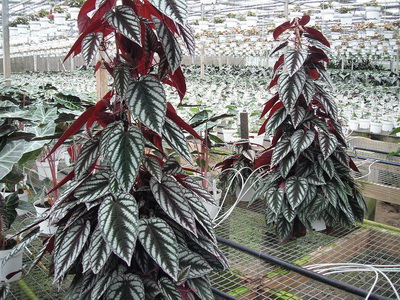
“Birch” is thermophilic (the temperature throughout the year is +18 +20 ° C) and shade-tolerant (it grows even with artificial lighting). Water abundantly throughout the year, it is desirable to spray during the heating period. Not afraid of drafts and tobacco smoke. For planting, a soil mixture of soddy and leafy soil, sand (1: 1: 0.5) is used. It can be grown with a support, it can be grown as an ampelous plant.
The healing effect of cissus on indoor air is associated with air humidification, the absorption of formaldehyde (which can be released into the air from chipboard), and the production of phytoncides.







